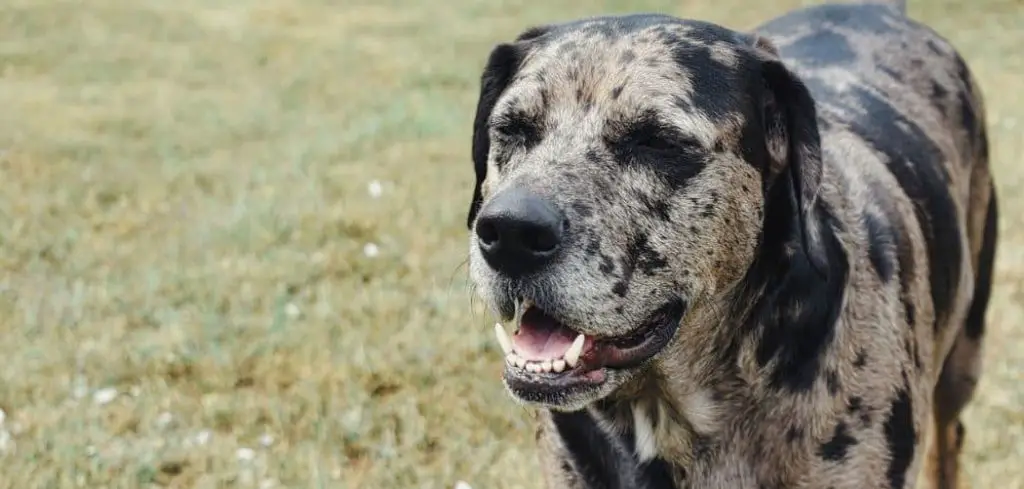Panting and smiling in dogs can be both adorable and puzzling. While panting often signals heat, exertion, or stress, a dog’s “smile” may be a sign of relaxation, or even discomfort in certain contexts.
We outline the reasons why dog panting and smiling happens, what you can do at home, and when to seek veterinary help.
Table of Contents
Dog Panting and Smiling — Why It Happens
Dog panting and smiling often occur together due to a mix of physical exertion, emotional states, and environmental factors. This combination can be completely normal after play, walks, or when greeting a favorite person.
However, it can also indicate overheating, anxiety, pain, or underlying medical issues.
Understanding the context and body language is key to knowing whether your dog’s panting and smiling is harmless or a sign of trouble.

Common Causes of Dog Panting and Smiling
Happiness and Excitement
Many dogs pant and display a relaxed “smile” when they’re happy. This often happens during playtime, walks, or social interaction.
The panting helps regulate body temperature, while the open mouth and upturned lips signal positive emotions.
Look for other signs of contentment such as a wagging tail, relaxed posture, and bright eyes.
If these accompany panting and smiling, it is likely a normal response to joy and stimulation.
Cooling Down After Exercise
Panting is a dog’s primary way to cool off after physical activity. The open-mouth expression may look like a smile, but it serves a physiological purpose: helping air circulate to reduce body temperature.
If your dog appears otherwise relaxed and recovers quickly, this post-exercise panting and smiling is usually nothing to worry about.
Prolonged or labored panting, however, could mean overexertion.
Related: Dog panting excessively (Causes and What To Do)
Heat Exposure
Warm weather can cause both panting and what looks like smiling as dogs open their mouths to release heat.
This becomes risky when temperatures are high or humidity prevents effective cooling.
Warning signs include excessive drooling, lethargy, or unsteady movement. In severe cases, this can progress to heatstroke, which is a veterinary emergency.
Anxiety or Stress
Dogs also pant when stressed, and their facial expression can sometimes resemble a smile.
Anxiety-related panting is often paired with restlessness, pacing, lip licking, or avoidance behaviors.
This may occur during vet visits, car rides, or exposure to loud noises. Unlike a happy smile, the muscles around the eyes may appear tense, and the panting may be faster.
Pain or Discomfort
Pain can trigger panting as the body reacts to distress. A dog may also pull back its lips, creating a “smile-like” expression that is actually a pain grimace.
Look for limping, reluctance to move, whining, or guarding a specific area. Because dogs often hide pain, subtle facial cues combined with panting can be important indicators.
Medical Conditions
Respiratory or heart problems, hormonal imbalances, or fever can all cause panting. The relaxed or open-mouth appearance may be incidental to the underlying illness.
If panting and smiling occur without an obvious trigger like heat or excitement, and especially if they happen at rest, a veterinary check-up is warranted.
What to Do If Your Dog Is Panting and Smiling
First, assess the situation. If your dog has been active or the weather is warm, offer water and rest in a cool, shaded area. Observe body language and look for signs of stress or pain.
If anxiety seems to be the cause, remove your dog from the triggering situation and provide reassurance. Keep the environment calm and quiet.
For dogs panting after exercise, allow them to cool down gradually. Avoid strenuous activity in hot weather, and always ensure access to fresh water.
If panting seems excessive, your dog appears distressed, or symptoms appear without clear cause, contact your veterinarian for guidance.
When to Call or Visit Your Vet
Seek immediate veterinary attention if your dog shows signs of heatstroke, such as rapid breathing, drooling, vomiting, weakness, or collapse. Blue or pale gums also require urgent care.
If panting and smiling happen at rest, are accompanied by coughing, lethargy, loss of appetite, or signs of pain, schedule a vet appointment promptly.
Dogs with known heart or respiratory conditions that develop increased panting should be evaluated without delay.
Read more: Dog panting and excited (Here’s why)
Key Takeaway
Panting and smiling in dogs can range from a sign of happiness to a warning of serious health concerns.
By paying attention to context, accompanying behaviors, and changes in your dog’s normal patterns, you can better understand the cause.
When in doubt, consult your veterinarian to ensure your dog stays healthy, safe, and comfortable.
